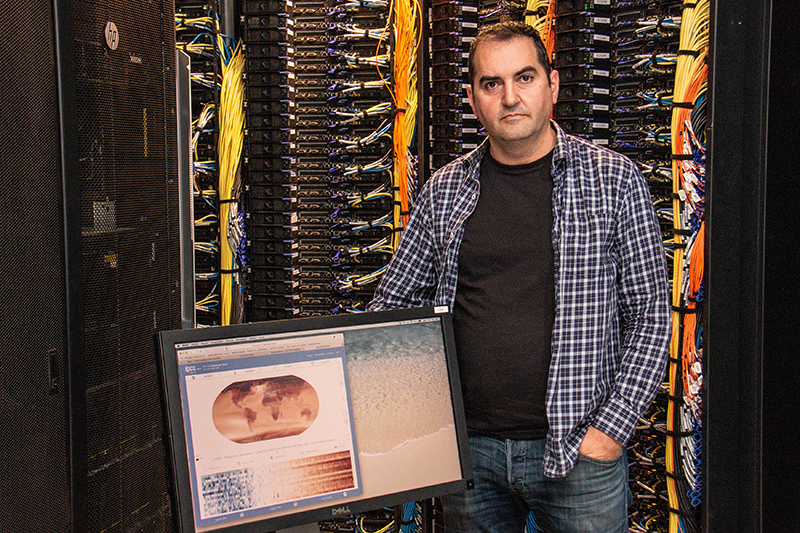
January 28, 2020
Advances in science are closely linked to advances in technology. In case of climate change and our ability to predict its consequences, the current availability of supercomputers and networks that process enormous amounts of information, is key to achieving global and also regional predictive models, i.e. with a higher level of accuracy. Another key challenge is how to consult this huge amount of climate information on which to base far-reaching political decisions for the short, medium and long term future.
Thanks to the scientific and technological leadership of the Instituto de Física de Cantabria (IFCA, a joint CSIC-UC centre) in collaboration with the Department of Applied Mathematics and Computer Science of the Universidad de Cantabria (UC), a group of researchers is coordinating the 'star' project of the next report -the sixth- of the United Nations Intergovernmental Panel on Climate Change (IPCC). The new challenge is an interactive Atlas that the IPCC has commissioned to the Meteorology Group through IFCA, due to its previous experience developing elements of this type for the National Plan of Adaptation to Climate Change and FAO. This group, composed of 20 people and led by José Manuel Gutiérrez Llorente, director of IFCA, which relies on its technological alliance with the spin-off Predictia for web development, thus becomes a support center of IPCC at same level as Germany, United Kingdom or United States, through NASA.
After a year of work, Gutiérrez and his team have already produced two drafts of the report, which is submitted for review by both scientists and governments. "Each product has to be validated", which means responding, one by one, to thousands of comments made by reviewers in a "very guaranteed" process. "That's why it was difficult to get acceptance for an interactive product”, explains the expert, "but we finally convinced them of its necessity" and now "there is a lot of expectation with this product”.
The Atlas has two advantages over previous reports, based only on static documents: it allows you to consult the maps in a flexible way, choosing an area and time period or season, and it tries to make it easier information to reach people, since its interface is much more attractive. "We are also leading the way in open science: each figure in Atlas has metadata explaining how it was done, thus being reproducible, which is a milestone in IPCC's field," says José Manuel Gutiérrez.
The final result will be published in April 2021 and will allow basic variables of climate change - precipitation, temperature, wind - to be consulted through sets of information that will be housed in Santander Climate Data Service, coordinated by Antonio Cofiño, and in IFCA's "cloud" system. These systems are joined by Altamira supercomputer, which allows regional simulations to be carried out by another member of Meteorology Group, Jesús Fernández.
In this field, "we have to tread on solid methodology and have the appropriate technology to launch necessary computation that will make studies reliable," explains Gutiérrez. Since this is a complex scenario, all basic information depends on large collaborative initiatives such as CMIP - experimental modeling framework - or CORDEX, a framework, whose purpose is to nest high resolution models to obtain greater detail of the regional climate (between 10 and 40 kilometers), necessary to analyze what is going to happen, for example, in Cantabria. For all this, we must face computational challenge that implies, "considering an enormous amount of data". Of the 500 most powerful supercomputers in the world today, including the IFCA's CPD, 50 run exclusively models such as climate models, which means several "petabytes" (1015 bytes) of information stored in various centres.
Thanks to this project, Cantabria plays a fundamental role in the impact studies, will allow governments all over the world to take measures. Gutiérrez is one of the two Spanish who coordinate some chapters of sixth report (there are 15 other authors from our country). The known scenarios between now and year 2100, speak of an average rise in temperatures of between 6 and 7 degrees if nothing is done, and achieving 'only' between 1.5 and 2 degrees, would be the objective set at Paris Summit.
"Spain has led the last COP precisely because it is betting very strongly on this issue. Everyone has to do their homework," says Gutiérrez. In his opinion, we must focus on our power as consumers. "Companies are going to follow what people tell them to do", so in his opinion we must reflect on our individual consumption model. "Climate change and sustainability are two aligned objectives", he points out, concluding that there must be social movements that demand laws, as is happening in our country.
Video of the report made by Universidad de Cantabria (UC): https://www.youtube.com/watch?v=KjXp8NwwWMQ&feature=emb_title
